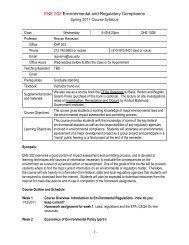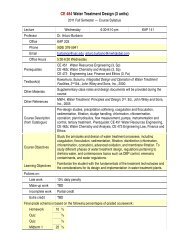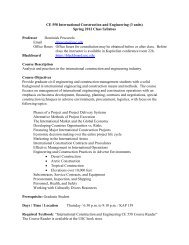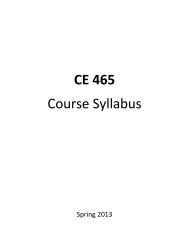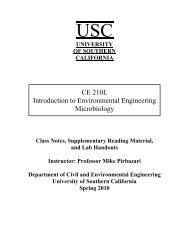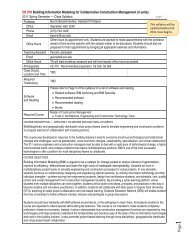The Importance of Sanitation and Hygiene Practices in ... - USC
The Importance of Sanitation and Hygiene Practices in ... - USC
The Importance of Sanitation and Hygiene Practices in ... - USC
Create successful ePaper yourself
Turn your PDF publications into a flip-book with our unique Google optimized e-Paper software.
By: Peter Grasso<br />
Undergraduate Research Student<br />
<br />
<br />
Faculty Supervisor: Pr<strong>of</strong>essor Massoud Pirbazari<br />
Sonni Astani Department <strong>of</strong> Civil <strong>and</strong> Environmental Eng<strong>in</strong>eer<strong>in</strong>g<br />
Viterbi School <strong>of</strong> Eng<strong>in</strong>eer<strong>in</strong>g<br />
University <strong>of</strong> Southern California
S.W.A.N. is an <strong>in</strong>itiative started by Pr<strong>of</strong>essor Massoud<br />
Pirbazari <strong>of</strong> the University <strong>of</strong> Southern California focus<strong>in</strong>g<br />
on the improvement <strong>of</strong> dr<strong>in</strong>k<strong>in</strong>g water quality for citizens <strong>of</strong><br />
develop<strong>in</strong>g countries. SWAN's goal is to provide<br />
comprehensive <strong>and</strong> visually based <strong>in</strong>formation so that<br />
people, at the household level, can treat their water, <strong>and</strong> <strong>in</strong><br />
turn, improve their health <strong>and</strong> well-be<strong>in</strong>g.
THIS SITE IS UNDER CONSTRUCTION.<br />
All material <strong>in</strong>cluded <strong>in</strong> this presentation have been<br />
adapted from sources* listed on the f<strong>in</strong>al slide.<br />
* We would like to thank those whose work has been<br />
pivotal <strong>in</strong> the creation <strong>of</strong> this site.<br />
(See Reference Page for Sources)
To the Visitor,<br />
Your comments <strong>and</strong> suggestions are appreciated. Please<br />
direct your thoughts to Peter Grasso at pgrasso@usc.edu<br />
Thank you.
• This slide presentation will:<br />
− Express <strong>and</strong> highlight the importance <strong>of</strong> sanitation <strong>and</strong> hygiene<br />
practices <strong>in</strong> improv<strong>in</strong>g water quality <strong>and</strong> the st<strong>and</strong>ard <strong>of</strong> liv<strong>in</strong>g <strong>in</strong><br />
develop<strong>in</strong>g nations.<br />
− Explore the advantages <strong>and</strong> disadvantages <strong>of</strong> various common<br />
latr<strong>in</strong>e designs.<br />
− Provide plans for the construction <strong>of</strong> a biodigester latr<strong>in</strong>e.<br />
• <strong>The</strong> <strong>in</strong>formation below is for the benefit <strong>of</strong> rural communities <strong>in</strong><br />
develop<strong>in</strong>g nations.
• 2.6 billion people (40% <strong>of</strong> world’s<br />
population) lack access to improved<br />
sanitation services.<br />
• Unhygienic habits <strong>and</strong> poor or<br />
nonexistent sanitation facilities<br />
greatly <strong>in</strong>crease susceptibility to<br />
diarrhea, cholera, typhoid <strong>and</strong> a<br />
number <strong>of</strong> parasitic <strong>in</strong>fections.<br />
• In total, 2.2 million deaths annually<br />
arise due to <strong>in</strong>adequate sanitation<br />
practices, a lack <strong>of</strong> safe dr<strong>in</strong>k<strong>in</strong>g<br />
water, <strong>and</strong> poor hygiene <strong>in</strong><br />
develop<strong>in</strong>g nations .
• <strong>Sanitation</strong> <strong>and</strong> <strong>Hygiene</strong> play major roles <strong>in</strong> the prevention <strong>of</strong><br />
illness, for example:<br />
− A 2004 study estimates that poor quality water, sanitation,<br />
<strong>and</strong> hygiene habits account for 5.7 per cent <strong>of</strong> world wide<br />
disease burden.<br />
− Approximately 81 million years <strong>of</strong> healthy life are lost each<br />
year most <strong>of</strong> which could be elim<strong>in</strong>ated with simple<br />
improvements <strong>in</strong> the areas <strong>of</strong> water supply, sanitation<br />
services, <strong>and</strong> hygiene practices.<br />
• Illness prevention through simple sanitation services <strong>and</strong><br />
hygiene practices is a cheaper alternative to illness treatment.<br />
−<br />
Illness prevention also reduces the number school <strong>and</strong><br />
work days missed with<strong>in</strong> a community which <strong>in</strong> turn helps<br />
<strong>in</strong>crease societal productivity.
• <strong>Sanitation</strong> entails:<br />
−<br />
−<br />
−<br />
Human excreta management, disposal <strong>and</strong> re-use<br />
Solid waste (refuse) management<br />
Management <strong>of</strong> hazardous wastes<br />
• <strong>Hygiene</strong> entails:<br />
−<br />
−<br />
−<br />
Effective personal hygiene<br />
Safe h<strong>and</strong>l<strong>in</strong>g <strong>and</strong> treatment <strong>of</strong> food<br />
Safe water storage
Refuse<br />
St<strong>and</strong><strong>in</strong>g water<br />
Vectors<br />
(e.g. mosquitoes)<br />
Vectors<br />
(e.g. flies, fleas, mice, rats)<br />
(Flea)<br />
Poor, overcrowded<br />
hous<strong>in</strong>g<br />
Typhus<br />
Chagas’ Diease<br />
Tuberculosis<br />
Malaria<br />
Filariasis<br />
(Fly)<br />
Diarrhoea<br />
Roundworm<br />
Flies<br />
Bilharzia<br />
Food<br />
Vectors<br />
Cholera<br />
Diarrhoea<br />
Gu<strong>in</strong>eaworm<br />
Dirty H<strong>and</strong>s<br />
(If not washed<br />
after defecation)<br />
Contam<strong>in</strong>ated<br />
water<br />
Cryptosporidiosis<br />
Hepatitis A<br />
Soil<br />
Animals<br />
(e.g. cattle, sheep, pigs)<br />
(if eaten<br />
undercooked)<br />
Tapeworm<br />
Open defecation<br />
Bare feet<br />
Hookworm
• Diarrheal diseases are a major problem <strong>in</strong> develop<strong>in</strong>g nations <strong>and</strong><br />
proper sanitation <strong>and</strong> hygiene techniques can drastically reduce<br />
susceptibility to diarrheal diseases.<br />
−<br />
Diarrheal diseases directly kill 2 million children a year <strong>and</strong> are a contribut<strong>in</strong>g<br />
factor to 18 million other deaths a year.<br />
−<br />
Diarrheal related illnesses are the second greatest cause <strong>of</strong> mortality <strong>and</strong><br />
morbidity <strong>in</strong> children under five years old (17-21%).<br />
−<br />
85-90% <strong>of</strong> diarrheal illnesses <strong>in</strong> develop<strong>in</strong>g countries can be attributed to<br />
<strong>in</strong>adequate sanitation, poor hygiene practices, <strong>and</strong> unsafe water usage.
• H<strong>and</strong> wash<strong>in</strong>g is essential to decreas<strong>in</strong>g <strong>in</strong>cidence<br />
<strong>of</strong> illness; accord<strong>in</strong>g to a 2008 study, h<strong>and</strong><br />
wash<strong>in</strong>g after defecation has been shown to<br />
reduce episodes <strong>of</strong> diarrhea by 30%.<br />
• Wash<strong>in</strong>g your h<strong>and</strong>s helps remove any bacteria<br />
<strong>and</strong> parasites present.<br />
• To ensure that one’s h<strong>and</strong>s have been effectively<br />
washed one must consider five key criteria :<br />
1. Length <strong>of</strong> wash<br />
2. Use <strong>of</strong> a Scrubb<strong>in</strong>g agent<br />
3. Frequency <strong>of</strong> wash<br />
4. Method <strong>of</strong> dry<strong>in</strong>g<br />
5. Quantity <strong>of</strong> water used
1. Length <strong>of</strong> wash<br />
−<br />
H<strong>and</strong>s should be scrubbed for at least 20 seconds<br />
2. Use <strong>of</strong> a Scrubb<strong>in</strong>g Agent<br />
−<br />
<strong>The</strong> use <strong>of</strong> a scrubb<strong>in</strong>g agent is an essential part <strong>of</strong> h<strong>and</strong><br />
wash<strong>in</strong>g. If access to soap is limited, ash can be used as a<br />
suitable alternative.<br />
• Studies have shown that the use <strong>of</strong> a scrubb<strong>in</strong>g agent<br />
reduces the risk <strong>of</strong> diarrhea <strong>in</strong> the general population by<br />
42-44%<br />
3. Frequency<br />
−<br />
H<strong>and</strong>s should be washed multiple times a day <strong>in</strong>clud<strong>in</strong>g before<br />
prepar<strong>in</strong>g food, eat<strong>in</strong>g, <strong>and</strong> feed<strong>in</strong>g a child, <strong>and</strong> after us<strong>in</strong>g a<br />
toilet, car<strong>in</strong>g for an ill family member, <strong>and</strong> chang<strong>in</strong>g a diaper<br />
4. Method <strong>of</strong> Dry<strong>in</strong>g<br />
−<br />
H<strong>and</strong>s should either be air-dried or dried with a clean cloth
5. Quantity <strong>of</strong> water used<br />
• Should be between 1 <strong>and</strong> 2 liters<br />
− Studies have shown a significant decrease <strong>in</strong> h<strong>and</strong> coliform<br />
counts <strong>of</strong> <strong>in</strong>dividuals who used 2 liters <strong>of</strong> water while wash<strong>in</strong>g<br />
their h<strong>and</strong>s compared to <strong>in</strong>dividuals who used 0.5 liters.<br />
• If the quantity <strong>of</strong> fresh water is limited, use <strong>of</strong> a “tippy-tap” can help conserve<br />
water.<br />
− A “tippy-tap” is a simple <strong>and</strong> cost effective water sav<strong>in</strong>g device<br />
that m<strong>in</strong>imizes excess water waste while one washes there<br />
h<strong>and</strong>s.
1. Select a plastic conta<strong>in</strong>er that<br />
has a h<strong>and</strong>le <strong>and</strong> can hold<br />
around 5 liters.<br />
2. Heat the base <strong>of</strong> the h<strong>and</strong>le<br />
with a c<strong>and</strong>le until the plastic is<br />
s<strong>of</strong>t without melt<strong>in</strong>g it.<br />
3. When the plastic is s<strong>of</strong>t, p<strong>in</strong>ch<br />
the base <strong>of</strong> the h<strong>and</strong>le closed<br />
with a pair <strong>of</strong> pliers <strong>and</strong> let it<br />
cool. Make sure that no water<br />
can get through the p<strong>in</strong>chclosed<br />
base.
1. D<br />
2. D<br />
3. D<br />
4. With a hot nail, make a 2mm<br />
hole just above the p<strong>in</strong>chclosed<br />
base <strong>of</strong> the h<strong>and</strong>le.<br />
5. With a plastic or tw<strong>in</strong>e net,<br />
suspend the bottle from a<br />
metal support. Let one piece <strong>of</strong><br />
plastic h<strong>and</strong> down to suspend<br />
the soap from.<br />
6. Make a hole <strong>in</strong> the center <strong>of</strong><br />
soap. Suspend the soap with a<br />
str<strong>in</strong>g through the hole <strong>and</strong><br />
place a metal or plastic cover<br />
above the soap to protect it<br />
from sun <strong>and</strong> ra<strong>in</strong>.
• Three major ways to <strong>in</strong>crease future hygiene <strong>and</strong> sanitation practices<br />
− Public education<br />
− Implementation <strong>of</strong> <strong>Hygiene</strong> <strong>and</strong> <strong>Sanitation</strong> practices <strong>in</strong> schools<br />
− Empowerment <strong>of</strong> women to leadership positions
• <strong>Hygiene</strong> education should take place on<br />
all community levels<br />
− Schools, cl<strong>in</strong>ics, market-places,<br />
community mean<strong>in</strong>gs, <strong>and</strong> places <strong>of</strong><br />
worship<br />
• Picture based pamphlets for the illiterate<br />
• It is important to start hygiene education<br />
at schools because habits that people<br />
adopt as children have a tendency to stay<br />
with them for life
• School is a good place to promote hygiene <strong>and</strong> sanitation practices<br />
<strong>and</strong> therefore teachers must be effective advocates <strong>of</strong> sanitation<br />
practices.<br />
• Promotion h<strong>and</strong> wash<strong>in</strong>g <strong>in</strong> school reduces diarrheal episodes.<br />
• Adequate school latr<strong>in</strong>e design plays an important role <strong>in</strong> keep<strong>in</strong>g<br />
students <strong>in</strong> school while advocat<strong>in</strong>g sanitation practices.<br />
−<br />
−<br />
−<br />
−<br />
One latr<strong>in</strong>e should be used by no more then 30 student<br />
Bathrooms should be gender specific<br />
1 <strong>in</strong> 10 African school-aged girls do not attend dur<strong>in</strong>g<br />
menstruation <strong>and</strong> consequently short absences compound<br />
over time <strong>and</strong> negatively impacts a girl’s learn<strong>in</strong>g abilities<br />
School girls drop out rate <strong>in</strong>creases due to a lack <strong>of</strong> private<br />
<strong>and</strong> clean sanitation facilities.
• In a number <strong>of</strong> cultures it is the woman’s duty to fetch water.<br />
• In most develop<strong>in</strong>g countries rural women produce 60-80 % <strong>of</strong> food.<br />
−<br />
Be<strong>in</strong>g <strong>in</strong> charge <strong>of</strong> food production <strong>and</strong> water retrieval these women deal with hygiene <strong>and</strong><br />
sanitation on a daily basis.<br />
• Convenient access to dr<strong>in</strong>k<strong>in</strong>g water reduced time spent collect<strong>in</strong>g water by<br />
women <strong>and</strong> young girls by 50 to 90 per cent.<br />
• Water rights <strong>of</strong>ten tied to l<strong>and</strong> ownership. Women own less than 2 per cent<br />
<strong>of</strong> the world’s private l<strong>and</strong>.<br />
• Women are not allowed to own l<strong>and</strong> <strong>in</strong> Burk<strong>in</strong>a Faso, Cameroon, <strong>and</strong><br />
Zimbabwe.
• In most third world countries<br />
women are <strong>in</strong> charge <strong>of</strong> sanitation,<br />
health, <strong>and</strong> household water<br />
supply.<br />
• In these societies there is a<br />
disproportionate amount <strong>of</strong> men <strong>in</strong><br />
positions <strong>of</strong> leadership.<br />
• In order to ga<strong>in</strong> awareness <strong>and</strong><br />
advocacy for global water <strong>and</strong><br />
sanitation agenda, women need to<br />
ga<strong>in</strong> more leadership positions.<br />
Ethiopian women transport<strong>in</strong>g water
• Around 34 Million people have HIV/AIDS<br />
• People liv<strong>in</strong>g with HIV/AIDS (PLWHA) are more prone to common<br />
disease <strong>and</strong> illnesses<br />
−<br />
−<br />
90% experience Diarrhea symptoms<br />
Diarrhea reduces the effectiveness <strong>of</strong> medic<strong>in</strong>es <strong>and</strong> the bodies<br />
<strong>in</strong>take <strong>of</strong> essential nutrients<br />
• Due to the frequent illness PLWHA have reduced mobility, mak<strong>in</strong>g it<br />
harder for them to collect water<br />
−<br />
PLWHA need 20-80 liters <strong>of</strong> water a day<br />
− Much <strong>of</strong> this water is needed for sanitiz<strong>in</strong>g the liv<strong>in</strong>g space <strong>of</strong><br />
the patient.<br />
• Family members should help properly dispose <strong>of</strong> the patients excreta.<br />
• Bedbound patients<br />
−<br />
−<br />
A commode or bedpan should be nearby so that excreta can be<br />
managed properly<br />
Plastic sheets should l<strong>in</strong>e the bed<br />
T-Cell Infected by HIV
• PLWHA <strong>and</strong> their families face many types <strong>of</strong><br />
discrim<strong>in</strong>ation from other members <strong>of</strong><br />
community.<br />
• Many families are reluctant to adopt water<br />
sav<strong>in</strong>g techniques <strong>and</strong> technologies such as<br />
tippy taps for fear <strong>of</strong> be<strong>in</strong>g suspected as HIV<br />
positive.<br />
• Reduc<strong>in</strong>g the stigma associated with HIV/AIDS<br />
will aid the promotion sanitation <strong>and</strong> hygiene.<br />
• Education plays a major role <strong>in</strong> reduc<strong>in</strong>g the<br />
stigma associated with HIV<br />
Picture <strong>of</strong> a “Tippy Tap” <strong>in</strong> use
• 1.2 billion people still practice open<br />
defecation<br />
• Proper excreta disposal is an <strong>in</strong>tegral part <strong>of</strong><br />
curb<strong>in</strong>g disease transmission<br />
−<br />
−<br />
Excreta should be disposed <strong>of</strong> away from<br />
sources <strong>of</strong> fresh water<br />
Excreta can be collected <strong>and</strong> used as<br />
fertilizer<br />
• Safe h<strong>and</strong>l<strong>in</strong>g <strong>and</strong> proper disposal <strong>of</strong> excreta<br />
can reduce the risk <strong>of</strong> diarrhoeal disease by<br />
30% or more
• Hygienic latr<strong>in</strong>e design plays a major role <strong>in</strong> reduc<strong>in</strong>g the transmission <strong>of</strong> bacteria <strong>and</strong><br />
viruses.<br />
• Latr<strong>in</strong>es should be wide enough to fit two people.<br />
−<br />
This allows for one to help an ill family member or friend.<br />
• <strong>The</strong>y should be designed to allow for natural light <strong>and</strong> ventilation<br />
• A squat pole should also be <strong>in</strong>cluded to help the elderly <strong>and</strong> sick<br />
• Soap or ash should be located nearby so that the occupant can wash his or her h<strong>and</strong>s.<br />
• <strong>The</strong> latr<strong>in</strong>e should be <strong>in</strong> an enclosed area to keep vectors out.<br />
• A vent pipe will allow for fumes to escape the latr<strong>in</strong>e.<br />
−<br />
A fly screen should be attached to the vent pipe’s open<strong>in</strong>g to stop flies from enter<strong>in</strong>g<br />
the latr<strong>in</strong>e.<br />
• A seat cover can help reduce odor when the latr<strong>in</strong>e is not <strong>in</strong> use.
• Pit Latr<strong>in</strong>e<br />
− Simple latr<strong>in</strong>e with a super structure <strong>and</strong> a pit for human excreta<br />
retention. <strong>The</strong> walls <strong>of</strong> the pit may be l<strong>in</strong>ed.<br />
• Ventilated Improved Pit Latr<strong>in</strong>e (VIP latr<strong>in</strong>e)<br />
− Advance pit latr<strong>in</strong>e with a l<strong>in</strong>ed pit. VIP latr<strong>in</strong>es reduce odor <strong>and</strong><br />
control vector populations<br />
• Ecological <strong>Sanitation</strong> (eco-san)<br />
− A ur<strong>in</strong>e divert<strong>in</strong>g latr<strong>in</strong>e that composts feces<br />
• Biodigester Latr<strong>in</strong>e<br />
− A latr<strong>in</strong>e that creates biogas usable for cook<strong>in</strong>g <strong>and</strong> composts waste
http://www.cartercenter.org/resources/pdfs/health/ephti/library/lecture_notes/env_health_science_students/ln_human_waste_f<strong>in</strong>al.pdf<br />
• A pit latr<strong>in</strong>e is <strong>of</strong>ten just<br />
a dug out hole with a<br />
super structure over the<br />
top<br />
• <strong>The</strong> hole is generally not<br />
l<strong>in</strong>ed <strong>and</strong> the waste<br />
created can easily<br />
pollute the ground water
• Advantages<br />
− Cheap <strong>and</strong> quick to build<br />
• Disadvantages<br />
− Easily pollutes ground water<br />
− Little to no protection from<br />
vectors<br />
− No ventilation or odor control<br />
http://www.cartercenter.org/resources/pdfs/health/ephti/library/lecture_notes/env_health_science_students/ln_human_waste_f<strong>in</strong>al.pdf
• A VIP Latr<strong>in</strong>e is designed to reduce<br />
the number <strong>of</strong> flies with<strong>in</strong> the<br />
latr<strong>in</strong>e <strong>and</strong> to disperse the odor.<br />
−<br />
−<br />
Both <strong>of</strong> these tasks are done<br />
via the use <strong>of</strong> a vent which<br />
connected to the pit itself.<br />
<strong>The</strong> vent be<strong>in</strong>g the only source<br />
<strong>of</strong> light with<strong>in</strong> the latr<strong>in</strong>e,<br />
attracts the flies, effectively<br />
trapp<strong>in</strong>g them with<strong>in</strong> the pipe<br />
until they die.<br />
http://www.cartercenter.org/resources/pdfs/health/ephti/library/lecture_notes/env_health_science_students/ln_human_waste_f<strong>in</strong>al.pdf
• Advantages<br />
− Cheap<br />
− Controls vector<br />
populations<br />
− <strong>The</strong> pit is l<strong>in</strong>ed with<br />
bricks to better control<br />
ground water pollution<br />
− Reduces odor<br />
• Disadvantages<br />
− Still has a chance <strong>of</strong><br />
pollut<strong>in</strong>g ground water<br />
http://www.cartercenter.org/resources/pdfs/health/ephti/library/lecture_notes/env_health_science_students/ln_human_waste_f<strong>in</strong>al.pdf
• EcoSan Toilets collect human excreta<br />
while separat<strong>in</strong>g ur<strong>in</strong>e <strong>and</strong> feces<br />
• To prevent ground water contam<strong>in</strong>ation<br />
human feces are separated from the<br />
soil by concrete floor<br />
• Feces can be composted <strong>and</strong><br />
eventually recycled as fertilizers for<br />
fields.<br />
−<br />
<strong>The</strong> nutrients with<strong>in</strong> the waste can<br />
be used to help fertilize fields<br />
http://www.ecosanres.org/pdf_files/Ecological_<strong>Sanitation</strong>.pdf
• Advantages<br />
− Human waste products are<br />
utilized as fertilizer<br />
− Little to no potential for ground<br />
water pollution<br />
− Reduces Odor<br />
• Disadvantages<br />
− More expensive than pit latr<strong>in</strong>es<br />
− Requires occasional<br />
ma<strong>in</strong>tenance<br />
− Ur<strong>in</strong>e tank has to be emptied<br />
weekly<br />
EcoSan Toilet <strong>in</strong> Rural Kenya<br />
http://www.ecosanres.org/pdf_files/Ecological_<strong>Sanitation</strong>.pdf
• Biodigester latr<strong>in</strong>es are similiar<br />
to ecological sanitation latr<strong>in</strong>es,<br />
they convert ‘waste’ <strong>in</strong>to useful<br />
products<br />
−<br />
−<br />
<strong>The</strong> major difference is that ur<strong>in</strong>e<br />
<strong>and</strong> feces are mixed <strong>in</strong>to a slurry<br />
that undergoes a series <strong>of</strong><br />
anaerobic reactions result<strong>in</strong>g <strong>in</strong><br />
the production <strong>of</strong> biogas<br />
Biogas can then be used as a fuel<br />
for cook<strong>in</strong>g or light<strong>in</strong>g homes<br />
Example <strong>of</strong> a simple biodigester
• A biodigester latr<strong>in</strong>e converts fecal matter<br />
<strong>in</strong>to biogas through a series <strong>of</strong> anaerobic<br />
reactions<br />
• This gas can then be used as an energy<br />
source; the gas can help power homes <strong>and</strong><br />
cook meals<br />
• This type <strong>of</strong> latr<strong>in</strong>e is more expensive up<br />
front but ends up turn<strong>in</strong>g what is usually<br />
seen as waste <strong>in</strong>to useful products like<br />
fertilizer <strong>and</strong> gas power.<br />
• 1 kilogram <strong>of</strong> human fecal matter can<br />
produce between 0.020 <strong>and</strong> 0.028 m 3 <strong>of</strong><br />
biogas<br />
− A latr<strong>in</strong>e designed for the use <strong>of</strong> 180<br />
people will generate between 328 <strong>and</strong><br />
460 m 3 <strong>of</strong> biogas a year.<br />
Compound %<br />
Methane 55-70<br />
Carbon dioxide 30-50<br />
Nitrogen 0-15<br />
Hydrogen<br />
Sulfide<br />
0-3<br />
Hydrogen 0-3<br />
Composition <strong>of</strong> Biogas
• <strong>The</strong> follow<strong>in</strong>g slides will detail the proper construction <strong>of</strong> a biodigester<br />
latr<strong>in</strong>e, start<strong>in</strong>g first with a brief overview <strong>of</strong> the latr<strong>in</strong>e itself<br />
• <strong>The</strong>re are three ma<strong>in</strong> parts to the biodigester latr<strong>in</strong>e (as shown below)<br />
Latr<strong>in</strong>e Superstructure Biodigester Compos<strong>in</strong>g Pits
• <strong>The</strong> biodigester latr<strong>in</strong>e designed here<strong>in</strong> is for the use <strong>of</strong><br />
approximately 180 people<br />
• <strong>The</strong> latr<strong>in</strong>e superstructure is where people will go to the bathrooms<br />
<strong>and</strong> will not physically be connected to the biodigester<br />
• Excreta will then be transferred to the Biodigester where it will<br />
reside for 35 days while biogas is produced<br />
• <strong>The</strong> waste will then flow <strong>in</strong>to the compost<strong>in</strong>g pits where it will be<br />
stored until it is safe to use as fertilizer
• <strong>The</strong> first major part <strong>of</strong> the biodigester latr<strong>in</strong>e is the latr<strong>in</strong>e<br />
superstructure.<br />
−<br />
<strong>The</strong> biodigester latr<strong>in</strong>e will have two identical rectangular<br />
superstructures each with three toilets <strong>in</strong>side.<br />
−<br />
−<br />
− Two 50 L plastic drums will be positioned below each latr<strong>in</strong>e<br />
(one for ur<strong>in</strong>e, the other for feces)<br />
It is important to have two superstructures so that each<br />
gender can have their own latr<strong>in</strong>es.<br />
<strong>The</strong>se superstructures will have ur<strong>in</strong>e divert<strong>in</strong>g capabilities<br />
<strong>in</strong> order to optimize biogas production<br />
50L plastic drum
Front View <strong>of</strong> Latr<strong>in</strong>e Superstructure
• Task 1: Cover slab construction<br />
• Step 1. Construction <strong>of</strong> Ur<strong>in</strong>e Diversion <strong>and</strong> Latr<strong>in</strong>e<br />
Hole molds<br />
• Step 2. Position <strong>and</strong> Cast Cover slabs<br />
• Task 2: Latr<strong>in</strong>e Superstructure Foundation<br />
• Step 1. Excavate <strong>and</strong> Cast Foundation<br />
• Task 3: Superstructure Floor Construction<br />
• Step 1. Lay <strong>in</strong>itial layer <strong>of</strong> bricks<br />
• Step 2. Brick <strong>and</strong> mortar to a height <strong>of</strong> 0.7 m
• Task 4: Cover Slab placement<br />
• Task 5: Superstructure Wall Construction<br />
• Step 1. Brick <strong>and</strong> mortar all walls to a height <strong>of</strong> 2.8m<br />
• Step 2. Brick <strong>and</strong> mortar front walls an additional 0.2m<br />
• Step 3. Brick an mortar side walls to create an even slope from back<br />
to front wall<br />
• Task 6: Superstructure Stairs Construction<br />
• Task 7: Superstructure Ro<strong>of</strong> Construction<br />
• Step 1. Install ro<strong>of</strong><br />
• Step 2. Install doors<br />
• Step 3. Install Fly Screens above doors
Build<strong>in</strong>g materials necessary for the latr<strong>in</strong>e superstructures <strong>in</strong>clude:<br />
Material<br />
Quantity<br />
Bricks* for two super structures ~4300<br />
Concrete<br />
T<strong>in</strong> Sheet (2)<br />
Doors (6)<br />
Fly Screens (6)<br />
1.5 cubic meters<br />
Each 3.9 by 1.4 meters<br />
Each 2.0 by 0.80 meters<br />
Each 0.20 by 0.80 meters<br />
50 L Plastic Cans 12<br />
*Brick size for the latr<strong>in</strong>e super structure <strong>and</strong> compost<strong>in</strong>g pits <strong>of</strong> this project will be 0.23 by 0.11 by 0.07 meters (Length X Width X<br />
Depth) with .008 meters or mortar <strong>in</strong> between bricks
• <strong>The</strong> first task <strong>in</strong> construction <strong>of</strong> a latr<strong>in</strong>e superstructure is the build<strong>in</strong>g the latr<strong>in</strong>e cover slab.<br />
Schematic <strong>of</strong> a completed Latr<strong>in</strong>e Cover Slab
First<br />
• Cut a piece <strong>of</strong> wood <strong>in</strong>to an<br />
equilateral trapezoid with a height<br />
<strong>of</strong> 0.10 m <strong>and</strong> bases <strong>of</strong> 0.05 <strong>and</strong><br />
0.15 meters (<strong>The</strong> green piece)<br />
−<br />
Second:<br />
This piece will go directly up<br />
right<br />
• Cut separate pieces <strong>of</strong> wood <strong>in</strong>to<br />
two equal-sized right trapezoids<br />
with a height <strong>of</strong> 0.11 m <strong>and</strong> bases<br />
<strong>of</strong> 0.05 <strong>and</strong> 0.10 meters (the yellow<br />
pieces).<br />
• <strong>The</strong>se will be fitted to the first<br />
pieces slants
• Third:<br />
• Cut <strong>and</strong> fit an equilateral<br />
trapezoid <strong>in</strong>to the rema<strong>in</strong><strong>in</strong>g It<br />
will have a height <strong>of</strong> 0.112 m<br />
<strong>and</strong> bases <strong>of</strong> 0.05 <strong>and</strong> 0.15<br />
meters<br />
−<br />
• Fourth:<br />
Once all four pieces are put <strong>in</strong>to<br />
place they should be secured<br />
together<br />
• A cyl<strong>in</strong>der with height <strong>of</strong> 0.1 m<br />
<strong>and</strong> radius <strong>of</strong> 0.05 m must also<br />
be constructed<br />
• Fifth:<br />
• Construct 5 more Ur<strong>in</strong>e<br />
Divert<strong>in</strong>g <strong>and</strong> latr<strong>in</strong>e hole molds
• First:<br />
• Excavate six holes with dimensions <strong>of</strong> 0.66 by 0.90<br />
meters to a depth <strong>of</strong> 0. 1 meter<br />
• Second:<br />
• Align the ur<strong>in</strong>e divert<strong>in</strong>g <strong>and</strong> latr<strong>in</strong>e hole molds<br />
− <strong>The</strong> cyl<strong>in</strong>der’s orig<strong>in</strong> should be located on the midl<strong>in</strong>e <strong>of</strong><br />
the 0.66 m dimension, 0.29 meters away from the edge.<br />
− <strong>The</strong> ur<strong>in</strong>e divert<strong>in</strong>g mold should be l<strong>in</strong>ed up directly<br />
with the cyl<strong>in</strong>der 0.02 meters further from the end<br />
• Third<br />
• After the molds are put <strong>in</strong>to place with<strong>in</strong> the hole, the<br />
concrete should be poured
• After the cover slabs are completed the foundations for each superstructure should be<br />
poured<br />
• First:<br />
• Excavate (2) 3.90 by 1.40 meter holes to a depth <strong>of</strong> 0.10 meters<br />
• Second:<br />
• Fill the hole with concrete<br />
Latr<strong>in</strong>e Superstructure Foundation
• After the foundation has settled construction <strong>of</strong> the superstructure with bricks <strong>and</strong><br />
mortar should beg<strong>in</strong>.<br />
Schematic <strong>of</strong> the floor <strong>of</strong> the latr<strong>in</strong>e superstructure (backside view)
• Step 1:<br />
• Lay down <strong>in</strong>itial layer <strong>of</strong> bricks leav<strong>in</strong>g three 0.50 by 0.70 m<br />
rectangular spaces free <strong>of</strong> bricks<br />
• Step 2:<br />
• This three rectangular spaces should be separated by 0.6<br />
meters <strong>of</strong> brick on either side.<br />
• Build up the <strong>in</strong>itial layer <strong>of</strong> bricks to a height <strong>of</strong> 0.70 m
After bricks have been layered to a height <strong>of</strong> 0.7 m, cover slab placement can take place<br />
Cover Slab<br />
Superstructure’s floors with Cover Slabs
• Step 1:<br />
• L<strong>in</strong>e up cover slabs so that the 0.9m sides are flush with the back wall<br />
• <strong>The</strong> cover slabs should be placed so that they rest on equally on both<br />
sides <strong>of</strong> the hole<br />
• Step 2:<br />
• Cover slabs should then be mortared <strong>in</strong>to place <strong>and</strong> construction <strong>of</strong> the<br />
super structure walls can then beg<strong>in</strong>
<strong>The</strong> next step <strong>in</strong> build<strong>in</strong>g the superstructure is wall construction<br />
Schematic <strong>of</strong> latr<strong>in</strong>e superstructure (overhead view)
• First:<br />
• Brick <strong>and</strong> mortar all walls an additional<br />
height <strong>of</strong> 2.1m to reach a height <strong>of</strong><br />
2.8m<br />
• Second:<br />
• Brick <strong>and</strong> mortar the front walls an<br />
additional 0.2m to reach a total height<br />
<strong>of</strong> 3.0 m<br />
• Third:<br />
• Mortar <strong>and</strong> Brick the four side walls<br />
what ever additional height is needed<br />
to ma<strong>in</strong>ta<strong>in</strong> <strong>and</strong> even slope from the<br />
back to the front <strong>of</strong> the ro<strong>of</strong>.<br />
Side View <strong>of</strong> the Latr<strong>in</strong>e Super Structure
• Stairs should be built lead<strong>in</strong>g to all<br />
three doorways.<br />
• Stairs should reach a height <strong>of</strong> 0.70<br />
meters. Each step should 0.18<br />
meters high, giv<strong>in</strong>g you a total <strong>of</strong> 4<br />
stairs.<br />
Note: more <strong>in</strong>formation on stair<br />
construction can be found on the<br />
follow<strong>in</strong>g websites.<br />
http://howto.millardlumber.com/ostairs/outdoorstairs.htm<br />
http://www.doityourself.com/stry/h2buildoutdoorstairs#b
• First<br />
• Position <strong>and</strong> secure a corrugated t<strong>in</strong><br />
ro<strong>of</strong> sheet on top <strong>of</strong> each super<br />
structure (1.5 by 3.9 m)<br />
• Second:<br />
• Install 0.8 by 2.0 m doors <strong>in</strong> the<br />
doorways<br />
• Third:<br />
• Install 0.2 by 0.8 m mesh fly screens<br />
above each door.<br />
• This will prevent vectors from enter<strong>in</strong>g<br />
while reduc<strong>in</strong>g odor <strong>and</strong> lett<strong>in</strong>g <strong>in</strong> light
• <strong>The</strong> biodigester presented here<strong>in</strong> has a retention time <strong>of</strong> 35<br />
days.<br />
• It is 8 cubic meters <strong>and</strong> can h<strong>and</strong>le the waste <strong>of</strong> 180<br />
people.<br />
• It is important to keep a steady flow <strong>of</strong> waste go<strong>in</strong>g <strong>in</strong>to the<br />
Biodigester so the latr<strong>in</strong>e superstructures should be<br />
emptied daily <strong>in</strong>to the biodigester’s <strong>in</strong>let mixer.<br />
− A one to one volume ratio <strong>of</strong> fecal matter to ur<strong>in</strong>e should be put <strong>in</strong>to<br />
the mixer to create the optimal slurry for biogas production.<br />
− After the human excreta is put <strong>in</strong>to to the <strong>in</strong>let mixer <strong>and</strong> thoroughly<br />
mixed any left over ur<strong>in</strong>e should be stored for eventual use as<br />
fertilizer <strong>in</strong> fields.<br />
− <strong>The</strong> 50 liter drums should then be r<strong>in</strong>sed <strong>and</strong> replaced <strong>in</strong>to the<br />
latr<strong>in</strong>e super structure.
A 1.7<br />
B 1.3<br />
C 1.7<br />
D 0.65<br />
E 1.72<br />
F 1.35<br />
G 2.30<br />
H 1.05<br />
I 1.27<br />
J 1.75<br />
Length (m)<br />
Construction <strong>of</strong> a 4 cubic meter biodigester<br />
(See the above table for measurements)
Materials Unit Quantity Materials Unit Quantity<br />
Bricks Piece 1700 Socket Piece 3<br />
S<strong>and</strong> Bag 80 Elbow Piece 8<br />
Gravel Bag 40 Tee Piece 2<br />
Cement Bag 16 Union Piece 1<br />
6mm rod Meter 70 Nipple Piece 4<br />
Pa<strong>in</strong>t Liter 1 Ma<strong>in</strong> gas valve Piece 1<br />
Vertical Mixer<br />
device<br />
Piece 1 Water dra<strong>in</strong> Piece 1<br />
Inlet pipe Piece 2 Rubber hose Meter 1<br />
Dome gas pipe Piece 1 Gas stove Piece 1<br />
GI pipe Piece 12 Gas Lamp Piece 1<br />
Dome gas pipe Piece 1 Teflon tape Roll 2
• Digester should ideally be kept between<br />
30-40 degrees Celsius so the<br />
biodigester should be built somewhere<br />
that is sunny<br />
• Site proximity should be 10 meters or<br />
greater from groundwater wells <strong>and</strong><br />
bodies <strong>of</strong> fresh water.<br />
• Gas pipe length should be m<strong>in</strong>imized to<br />
decrease cost <strong>and</strong> potential for leak<br />
• Construction <strong>of</strong> the biodigester is a<br />
<strong>in</strong>volved process, for detailed<br />
<strong>in</strong>structions visit the follow<strong>in</strong>g website:<br />
http://www.scribd.com/doc/65716095/2011-04-27-Afghan-Biogas-Construction-Manual-FINAL
• In order to obta<strong>in</strong> optimal gas<br />
production human excreta<br />
needs to be mixed <strong>in</strong>to a<br />
slurry<br />
• This can be done by build<strong>in</strong>g<br />
a vertical mixer at the<br />
open<strong>in</strong>g to the biodigester.<br />
• Construction <strong>in</strong>formation can<br />
be on the follow<strong>in</strong>g website:<br />
http://www.scribd.com/doc/65716095/2011-04-27-Afghan-Biogas-Construction-Manual-FINAL
<strong>The</strong> f<strong>in</strong>al structure <strong>of</strong> a biodigester latr<strong>in</strong>e is its compost<strong>in</strong>g pits<br />
Schematics <strong>of</strong> the compost<strong>in</strong>g pits (side view)
• Compost<strong>in</strong>g pits are storage sites for the waste product <strong>of</strong> biogas production.<br />
• Two pits will be built side by side one meter away from the outlet <strong>of</strong> the Biodigester<br />
−<br />
<strong>The</strong> outlet <strong>of</strong> the biodigester should be one meter away from the middle <strong>of</strong> the<br />
5.3 m compost<strong>in</strong>g pit wall. This is to ensure that the outlet waste makes it <strong>in</strong>to<br />
both pits.<br />
• Each pit will have a retention time <strong>of</strong> 6 months so that pathogens can be elim<strong>in</strong>ated<br />
• After six months the waste <strong>in</strong> the compost<strong>in</strong>g pits can be used as fertilizer<br />
Material<br />
Quantity<br />
Bricks* 1950<br />
Concrete 2.8 m 3<br />
*Brick size for the latr<strong>in</strong>e super structure <strong>and</strong> compost<strong>in</strong>g pits <strong>of</strong> this project will be 0.233 by 0.107 by 0.069 meters<br />
(Length X Width X Height) with .008 meters or mortar <strong>in</strong> between bricks
• First:<br />
• Excavate a 5.30 by 5.30 m square hole to a depth <strong>of</strong> 1.9 m<br />
• Second:<br />
• Fill the bottom with a layer <strong>of</strong> concrete 0.1m thick<br />
Compost<strong>in</strong>g pit foundation
• After the cement has solidified construction <strong>of</strong> the walls can beg<strong>in</strong>.<br />
• Step 1<br />
• Divide the foundation <strong>in</strong>to two equal chambers separat<strong>in</strong>g the two with a l<strong>in</strong>e <strong>of</strong><br />
bricks.<br />
• Step 2:<br />
• Brick <strong>and</strong> mortar all walls <strong>in</strong>clud<strong>in</strong>g the wall div<strong>in</strong>g the two chambers to a height <strong>of</strong><br />
1.4 m<br />
• <strong>The</strong> rema<strong>in</strong><strong>in</strong>g 0.4 meters <strong>of</strong> height will be to slope the pipe exit<strong>in</strong>g the<br />
Biodigester to the <strong>in</strong>let <strong>of</strong> the <strong>of</strong> the compost<strong>in</strong>g pits to ensure that the<br />
slurry can flow <strong>in</strong>to the compost<strong>in</strong>g pits.<br />
• Step 3<br />
• Construct a ro<strong>of</strong> <strong>of</strong> the compost<strong>in</strong>g pit from available materials with dimensions <strong>of</strong><br />
5.3 by 5.3 meters
• <strong>Sanitation</strong> <strong>and</strong> hygiene practices are<br />
<strong>in</strong>timately tied to a population’s<br />
st<strong>and</strong>ard <strong>of</strong> liv<strong>in</strong>g <strong>and</strong> general wellbe<strong>in</strong>g.<br />
• Implementation <strong>of</strong> m<strong>in</strong>or<br />
improvements to exist<strong>in</strong>g sanitation<br />
<strong>and</strong> hygiene practices can<br />
dramatically decrease a given<br />
population’s susceptibility to<br />
debilitat<strong>in</strong>g illnesses.<br />
• Upgrad<strong>in</strong>g current latr<strong>in</strong>e technologies<br />
with<strong>in</strong> rural communities will not only<br />
reduce illness susceptibility with<strong>in</strong> a<br />
community, but can also provide a<br />
community with source <strong>of</strong> energy as<br />
well as a potential source <strong>of</strong> <strong>in</strong>come.
• <strong>The</strong> Design <strong>of</strong> Ventilated Improved Pit Latr<strong>in</strong>es, Duncan Mara, D., <strong>The</strong> World Bank, Wash<strong>in</strong>gton, 1984.<br />
• J Water Health. 2006;4 Suppl 1:41-57. Global challenges <strong>in</strong> water, sanitation <strong>and</strong> health. Moe CL, Rhe<strong>in</strong>gans<br />
RD.<br />
• Rosenbaum, J. (2010). How to <strong>in</strong>tegrate water, sanitation <strong>and</strong> hygiene <strong>in</strong>to HIV programmes. Geneva,<br />
Switzerl<strong>and</strong>, World Health Organization (WHO). 113 p.<br />
• Ashley, Bradley, Farai Chikwati, Jith<strong>in</strong> John, Joshua Petrohilos, Xan Smith, <strong>and</strong> Adam Szuml<strong>in</strong>ski. BIodigester<br />
Toilet. Tech. Eng<strong>in</strong>eers Without Borders, 14 June 2011. Web. 20 Aug. 2012.<br />
.<br />
• Bates, Liz. "Biogas | Practical Action." Biogas | Practical Action. Practical Action, 2007. Web. 20 Aug. 2012.<br />
.<br />
• Clasen, Thomas F., <strong>and</strong> S<strong>and</strong>y Cairncross. "Editorial: Household Water Management: Ref<strong>in</strong><strong>in</strong>g the Dom<strong>in</strong>ant<br />
Paradigm." Tropical Medic<strong>in</strong>e <strong>and</strong> International Health 9.2 (2004): 187-91. Pr<strong>in</strong>t.<br />
• "Death <strong>and</strong> DALYs from Selected Water-Related Diseases. 2000 <strong>and</strong> 2004." WaterWorld.org. World Health<br />
Organization, n.d. Web. 20 Aug. 2012.<br />
.<br />
• Eskey, S. A., R. G. Feachem, <strong>and</strong> J. M. Hughes. "Interventions For <strong>The</strong> Control Of Diar-Rhoeal Diseases Among<br />
Young Children." <strong>The</strong> Pediatric Infectious Disease Journal 3.6 (1984): 600. Pr<strong>in</strong>t.<br />
• Faris, Kebede, Tadese Alemayehu, Mamo Wubshet, <strong>and</strong> Dejene Hailu. Human <strong>and</strong> Other Liquid Waste<br />
Management. N.p.: n.p., 2002. Pr<strong>in</strong>t.<br />
• Mears, Edward T. "Biogas Plant Construction Manual Fixed-dome Digester: 4 to 20 Cubic Meters Download Pdf<br />
- GoGreen Energies Bio-gas or Gobar Gas Digester Plant Blog." Biogas Plant Construction Manual Fixed-dome<br />
Digester: 4 to 20 Cubic Meters Download Pdf - GoGreen Energies Bio-gas or Gobar Gas Digester Plant Blog.<br />
United States Forces, Apr. 2011. Web. 20 Aug. 2012. .
• Pruss, Annette, David Kay, Lorna Fewtrell, <strong>and</strong> Jamie Bartram. "Estimat<strong>in</strong>g the Burden <strong>of</strong><br />
Disease from Water, <strong>Sanitation</strong>, <strong>and</strong> <strong>Hygiene</strong> at a Global Level." Environmetnal Health<br />
Perspectives 110.5 (2002): 537-42. US National Library <strong>of</strong> Medic<strong>in</strong>e <strong>and</strong> National Institutes <strong>of</strong><br />
Health. Environmental Health Perspectives, May 2002. Web. 20 Aug. 2012.<br />
.<br />
• Sasse, Ludwig. "Biogas Plants." Deutsche Gesellschaft Für Internationale Zusammenarbeit,<br />
1988. Web. 20 Aug. 2012. .<br />
• USAID, <strong>and</strong> <strong>Hygiene</strong> Improvement Project. "Programm<strong>in</strong>g Guidance for Integrat<strong>in</strong>g Water,<br />
<strong>Sanitation</strong>, <strong>and</strong> <strong>Hygiene</strong> Improvement <strong>in</strong>to HIV/AIDS Programs." (n.d.): n. pag. Web. 20 Aug.<br />
2012. .<br />
• "Water, <strong>Sanitation</strong> <strong>and</strong> <strong>Hygiene</strong> St<strong>and</strong>ards for Schools <strong>in</strong> Low-cost Sett<strong>in</strong>gs." Ed. John Adams,<br />
Jamie Bartram, Yves Chartier, <strong>and</strong> Jackie Sims. World Health Organization, 2009. Web. 20 Oct.<br />
2012.
• http://artforgorillas.wildlifedirect.org/2010/03/08/healthy-gorillas-healthy-people/<br />
• http://www.wateraid.org/uk/what_we_do/susta<strong>in</strong>able_technologies/technologies/8<br />
858.asp<br />
• http://ec.europa.eu/research/dossier/do220305/projects_en.html<br />
• http://www.b1b2.org/EcoSan/<strong>in</strong>dex.htm<br />
• http://thehootfrommrowliy.wordpress.com/2011/02/27/africa-water-problems/<br />
• http://ecosankenya.blogspot.com/2011/01/ecosan-<strong>in</strong>-wajir-town-aldef.html<br />
• http://www.ong-eauetvie.org/us/notreaction.html<br />
• http://www.new<strong>in</strong>t.org/features/2008/08/01/toilets-facts/<br />
• http://co<strong>in</strong>vestigators.files.wordpress.com/2011/02/cameroon-dirty-water.jpg<br />
• http://www.worms<strong>and</strong>germsblog.com/2009/05/articles/animals/cats/prevent<strong>in</strong>g<strong>in</strong>fections-<strong>in</strong>-the-home/<br />
• http://www.dormex.co.uk/images/Un%20Drum%20Rect.jpg<br />
• http://annalaurabrown.com/wp-content/uploads/2012/11/soap-rose-geranium.jpg<br />
• http://blackbeautysdailytips.blogspot.com/2011/12/clean-h<strong>and</strong>s-clean-face.html<br />
• http://www.mar<strong>in</strong>ebuzz.com/2008/03/22/world-water-day-focuses-on-sanitation/


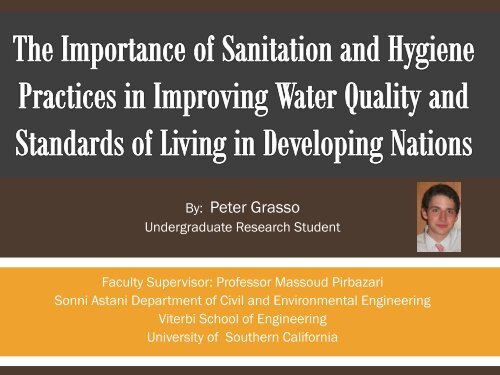




![Dr. Yan Xiao Bamboo Road Bridge can Support 16-Ton[ne] - USC](https://img.yumpu.com/37910641/1/190x245/dr-yan-xiao-bamboo-road-bridge-can-support-16-tonne-usc.jpg?quality=85)
